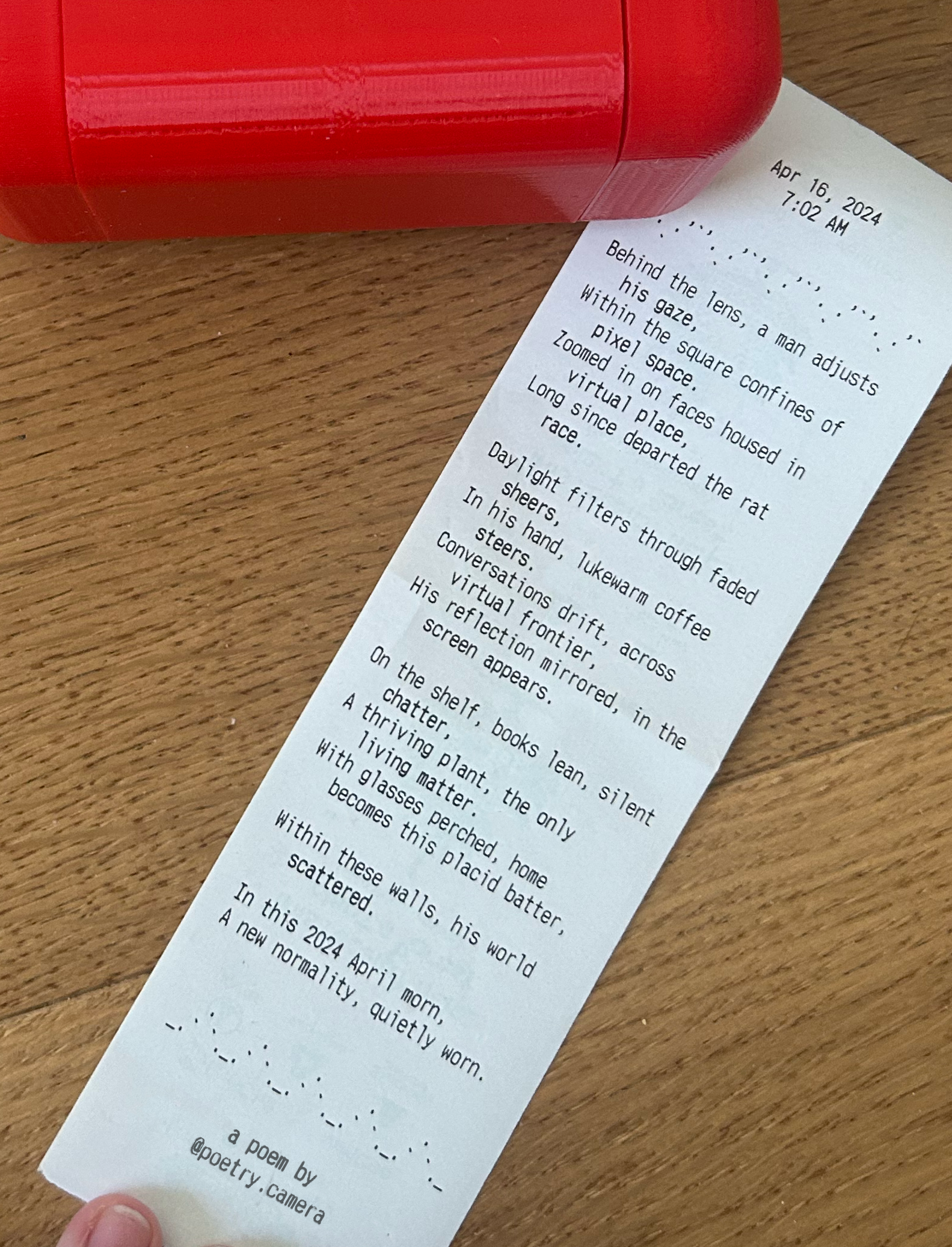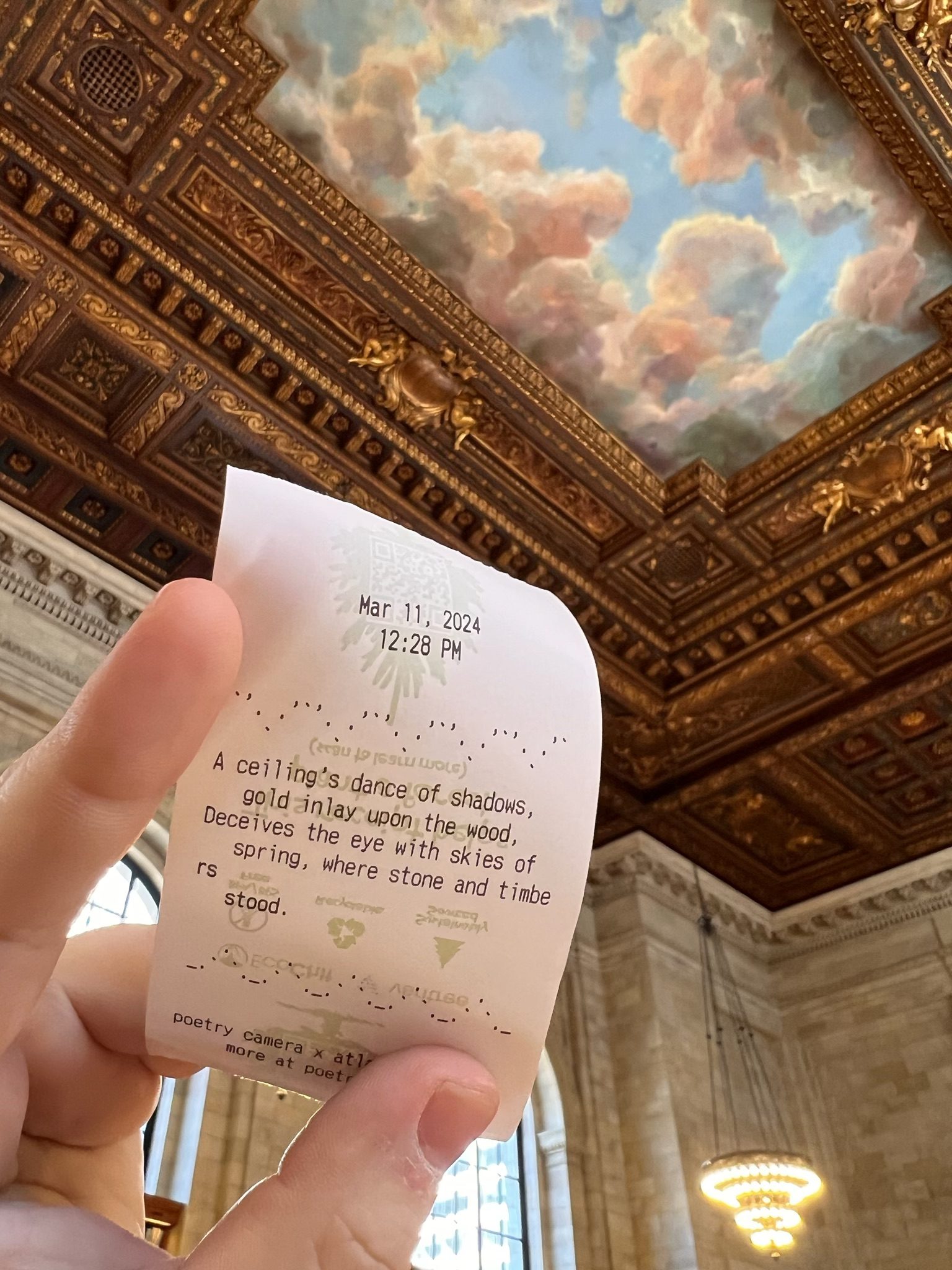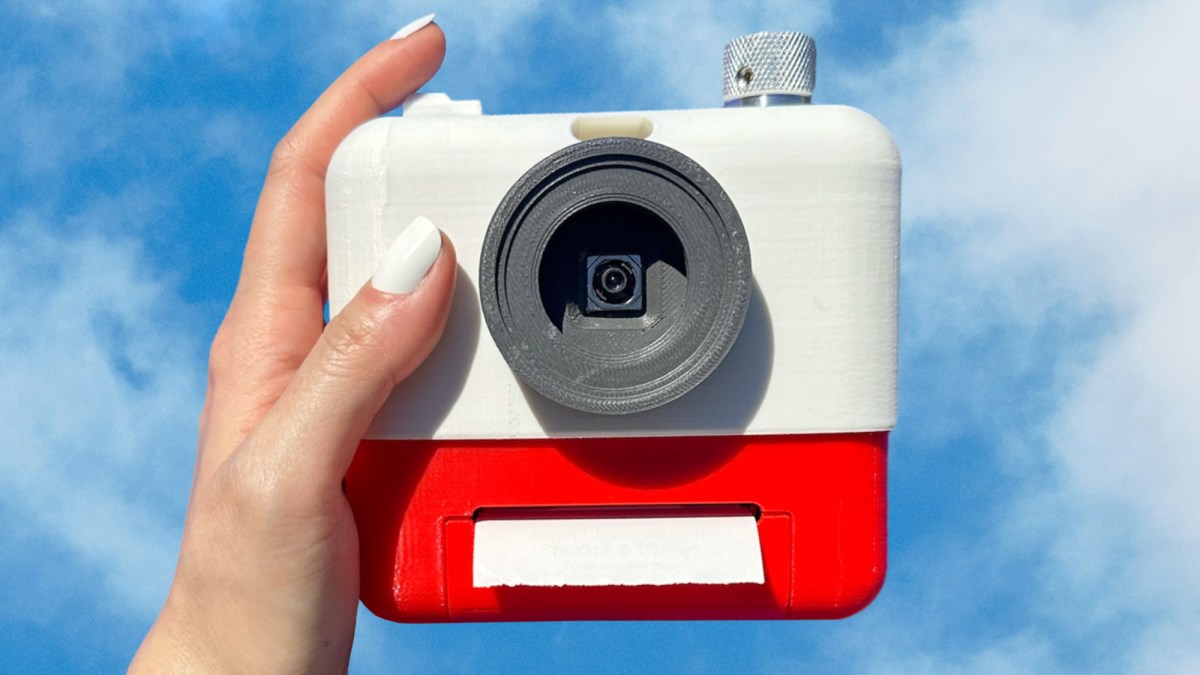The Poetry Camera: Where Technology Meets Art
Bridging the Gap Between AI and Creativity
Table of Contents
- Bridging the Gap Between AI and Creativity
- From Passion Project to Public Phenomenon
- The Technology Behind the Magic
- The Tech
- A Glimpse into the Future of AI
- The Poetry Digicam: A Unique Approach to Artistic Expression
- A Unique Blend of Technology and Creativity
- Embracing Ephemerality and Physical Connection
- A Journey of Discovery and Anticipation
- Shaping the Future of AI and Personal Computing
- A Commercial Future?
- The Poetry Camera: Where Art Meets Technology
- A Sustainable Approach to Innovation
- Bridging the Gap Between Art and Technology
- A Catalyst for Change
- The Intersection of Art, Technology, and Play: Exploring AI-Powered Creativity
- A New Lens on Artistic Expression
- Beyond Mimicry: Embracing the Power of Novelty
- The Future of Creative Collaboration
Have you ever stood before a majestic redwood tree and wished it could speak in verse? While Joyce Kilmer might not have envisioned this, Kelin Carolyn Zhang and Ryan Mather have brought this poetic dream to life with their innovative creation – the Poetry Camera. This open-source system seamlessly blends cutting-edge technology with artistic vision, pushing the boundaries of both fields.
At first glance, the Poetry Camera appears like any other digital device in today’s ever-evolving landscape. However, upon closer inspection, it reveals itself to be far more than just a camera. Instead of capturing static images, the Poetry Camera elevates the concept of photography by generating thought-provoking poetry (or as thought-provoking as AI poetry can get) based on the visuals it encounters. This unique fusion of technology and art has captivated audiences worldwide.
From Passion Project to Public Phenomenon
The story of the Poetry Camera began as a personal passion project for Zhang and Mather, who found themselves drawn to the idea of merging their love for technology with their appreciation for the arts. In the early stages of development, they spent countless hours tinkering with various components and experimenting with different AI models to bring their vision to life.
“The project’s origin was when I got access to GPT-3,” says Mather. “My first instinct was to play Dungeons & Dragons with it because I’m a nerd. I figured ‘if this thing could play Dungeons & Dragons, that would be spectacular.’ And yeah, it did work for that. This was back when you needed to do prompt engineering. So it took some elbow grease to get it to work. But I also had this idea of maybe making some camera as a project. What if you took a camera, but it was a response to Instagram culture? What if text comes out instead of a photo? … Everybody prefers the book model over the film, so it’s like that for capturing moments.”
As they refined their prototype, Zhang and Mather began sharing their creation with family and friends at social gatherings. The reactions they received were nothing short of astonishing. People were captivated by the idea of a camera that could generate poetry based on what it saw. The system quickly became the center of attention, sparking lively discussions and igniting the imaginations of all who encountered it.
These initial responses served as a powerful motivator for Zhang and Mather to continue refining their invention. They realized that the Poetry Camera had the potential to bridge the gap between technology and art in a way that resonated with people. As word of the Poetry Camera spread, the duo was inundated with inquiries from curious individuals eager to experience the system firsthand. This growing interest led them to consider the possibility of transforming their project into a commercially viable product, making the magic of the Poetry Camera accessible to a wider audience.
The Technology Behind the Magic
The Tech
At the heart of this groundbreaking system lies a Raspberry Pi, a credit card-sized single-board computer that packs a powerful punch. This tiny but mighty component serves as the brain of the Poetry Camera, enabling it to capture images and communicate with OpenAI’s GPT-4 to generate poetry.
A Raspberry Pi captures the image and then employs computer vision algorithms to analyze the visual data. The AI models then interpret the image, identifying key elements, colors, patterns, and emotions within the frame. This information serves as the inspiration for the poetry-generation process.
Zhang pointed the camera at our Zoom interview:
[Image of the Poetry Camera in action]
The Future of AI: A Conversation with Haje and Kelin
Ryan Mather and Kelin Carolyn Zhang in an interview along with your correspondent. Picture Credit:** Screenshot from Zoom
A Glimpse into the Future of AI
The world of artificial intelligence (AI) is rapidly evolving, with new breakthroughs happening almost daily. To gain a better understanding of this exciting field, we sat down with Ryan Mather and Kelin Carolyn Zhang, two leading experts in AI.
During our conversation, they shared their insights on the latest trends in AI, the potential impact of these technologies on society, and the ethical considerations that must be addressed as AI continues to advance.

A poem about the future of AI
Their insights offer a fascinating glimpse into the potential of AI to transform our world.
The Poetry Digicam: Where AI Meets Artistic Expression

The poem generated and printed by Poetry Digicam (transcribed beneath). Picture Credit: Poetry Digicam
Behind the lens, a person adjusts his gaze,
Inside the sq. confines of pixel area.
Zoomed in on faces housed in digital place,
Lengthy since departed the rat race.Daylight filters by pale sheers,
In his hand, lukewarm espresso steers.
Conversations drift, throughout digital frontier,
His reflection mirrored, within the display screen seems.On the shelf, books lean, silent chatter,
A thriving plant, the one residing matter.
With glasses perched, dwelling turns into his placid batter,
Inside this partitions, his world scattered.On this 2024 April morn,
A brand new normality, quietly worn.A poem by @poetry.digicam
The Poetry Digicam: A Unique Approach to Artistic Expression
The Poetry Digicam isn’t your typical AI art generator. This innovative device, created by [Insert Creators Names], goes beyond simply generating text; it crafts tangible poems printed on paper. Imagine the experience of receiving a personalized poem, not as a digital message but as a physical artifact you can hold and cherish.
This unique approach to artistic expression stems from the creators’ desire to bridge the gap between technology and human connection. The Poetry Digicam serves as a reminder that even in our increasingly digital world, there is still beauty and value in tangible creations.
 Learn more about Poetry Writing Tools
Learn more about Poetry Writing Tools
The Poetry Camera: Where AI Meets Artful Expression

A snapshot of the Poetry Camera in action. Image Credit:** Poetry Camera
A Unique Blend of Technology and Creativity
In a world saturated with digital content, the Poetry Camera stands out as a refreshing departure from the norm. This innovative device seamlessly blends artificial intelligence (AI) with artistic expression, offering users a unique way to engage with poetry and photography. The Poetry Camera generates original poems based on captured images, transforming everyday moments into captivating works of art.
Unlike traditional digital cameras that simply capture images, the Poetry Camera goes a step further by imbuing them with meaning through AI-generated verse. This fusion of technology and creativity creates a truly immersive experience for users, blurring the lines between art and technology.
Embracing Ephemerality and Physical Connection
The creators of the Poetry Camera, [Insert Names], have intentionally chosen to print the generated poems rather than displaying them digitally. This deliberate decision stems from several factors. Firstly, it simplifies the process, eliminating the need for complex digital storage and management. Secondly, it prioritizes user privacy by ensuring that the poems are not stored electronically.
Furthermore, printing the poems adds a layer of permanence and tangibility to the experience. Holding a physical copy of a poem generated from your own photograph fosters a deeper connection with the words and allows for a more contemplative engagement with the art form. This emphasis on physicality stands in stark contrast to the ephemeral nature of digital content, reminding us of the enduring power of tangible creations.
A Journey of Discovery and Anticipation
The Poetry Camera’s design philosophy extends beyond its core functionality, influencing every aspect of the user experience. From capturing an image to receiving the printed poem, each step is carefully crafted to evoke a sense of wonder and anticipation. The waiting period between capturing a photo and receiving the generated poem adds an element of suspense, heightening the excitement when the final product is revealed.
This deliberate pacing encourages users to slow down and appreciate the creative process, fostering a sense of mindfulness and engagement that is often absent in our fast-paced digital world. The Poetry Camera invites us to rediscover the joy of discovery and the beauty of unexpected creations.
Shaping the Future of AI and Personal Computing
The Poetry Camera serves as a microcosm of how AI can be integrated into our lives in meaningful and enriching ways. It challenges the notion that technology must always be about efficiency and productivity, demonstrating that it can also be a tool for creativity, self-expression, and human connection.
Zhang and Mather envision a future where AI seamlessly enhances our experiences without overwhelming us with constant stimulation. The Poetry Camera embodies this vision, offering a glimpse into a world where technology and art converge to create something truly special.
A Commercial Future?
While initially conceived as a personal project, the overwhelmingly positive response to the Poetry Camera has prompted Zhang and Mather to consider its commercial viability. The question of whether to make this unique creation accessible to a wider audience is a complex one, balancing artistic integrity with the desire to share their vision with the world.
Ultimately, the future of the Poetry Camera remains unwritten. However, its innovative approach to AI and art has already sparked conversations about the potential of technology to inspire creativity and connect us in meaningful ways.
The Poetry Camera: Where Art Meets Technology
In a world increasingly dominated by digital screens and instant gratification, there’s a growing desire for meaningful connections and creative expression. Enter the Poetry Camera, a unique device that blends the magic of analog photography with the power of artificial intelligence to generate evocative poems inspired by captured images.
A Sustainable Approach to Innovation
The minds behind the Poetry Camera, Zhang and Mather, are deeply committed to sustainability and responsible consumption. Rather than rushing into mass production, they’re taking a measured approach, prioritizing quality over quantity with limited product drops. This meticulous strategy ensures that each Poetry Camera is meticulously crafted with attention to detail, meeting their high standards for performance and durability.
This commitment to sustainability extends beyond the manufacturing process. The team acknowledges the environmental impact of creating new hardware and actively seeks ways to minimize their footprint. For example, they’ve explored using recycled materials and minimizing packaging waste. This dedication to ethical practices resonates with a growing consumer base that values responsible innovation.
Bridging the Gap Between Art and Technology
The Poetry Camera isn’t just about capturing images; it’s about sparking creativity and fostering a deeper connection with art. By combining photography with AI-powered poetry generation, the device encourages users to explore the intersection of these two disciplines in a truly unique way.
Imagine capturing a breathtaking sunset and then witnessing the Poetry Camera transform that moment into a poignant verse, capturing the essence of the scene in words as vivid as the image itself. This fusion of art and technology has the potential to unlock new forms of expression and inspire countless creative endeavors.
A Catalyst for Change
Zhang and Mather envision the Poetry Camera as more than just a novelty device; they see it as a catalyst for change in how we interact with technology and art. They hope their creation will inspire others to explore the intersection of these two fields, pushing the boundaries of what’s possible and creating new forms of expression.
The Poetry Camera represents a shift towards a more mindful and creative approach to technology. By blending art and innovation, it reminds us that technology can be a powerful tool for self-expression, connection, and exploration.

To learn more about the Poetry Camera and its potential to inspire your own creative journey, visit their website: https://www.poetrycamera.com/
The Intersection of Art, Technology, and Play: Exploring AI-Powered Creativity
A New Lens on Artistic Expression
In today’s rapidly evolving world, where technology constantly pushes boundaries, it’s fascinating to witness the convergence of art, innovation, and play. Projects like the Poetry Camera exemplify this exciting intersection, blurring the lines between traditional artistic mediums and cutting-edge AI capabilities.
This innovative device utilizes artificial intelligence to transform everyday moments into captivating visual poems. By capturing images and then weaving them together with poetic verses generated by an AI algorithm, the Poetry Camera offers a unique and interactive experience that invites users to explore the boundless potential of creative expression.
Beyond Mimicry: Embracing the Power of Novelty
The creators of this project emphasize that their goal is not simply to replicate human creativity but rather to harness the power of AI to forge something entirely new. As Zhang, a key figure behind the Poetry Camera, eloquently states, “It’s about making something fully new with its new expertise and bringing out that inner child again.” This sentiment highlights the project’s focus on fostering a sense of wonder and playfulness, reminding us that creativity can flourish when we embrace the unexpected.
For those eager to delve deeper into the Poetry Camera’s capabilities, TikTok serves as an excellent platform for exploration. [https://thetrendytype.com/ai-art](https://thetrendytype.com/ai-art) showcases a diverse range of creations, demonstrating the device’s versatility and potential to inspire artistic expression in unexpected ways.
The Future of Creative Collaboration
Projects like the Poetry Camera offer a glimpse into the future of creative collaboration between humans and AI. By leveraging the strengths of both, we can unlock new possibilities for artistic expression and push the boundaries of what’s imaginable. As technology continues to advance, it will be fascinating to witness how these collaborations evolve and shape the landscape of art in the years to come.


